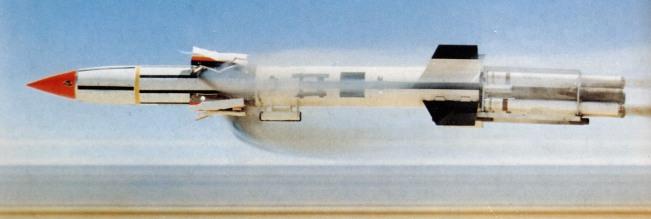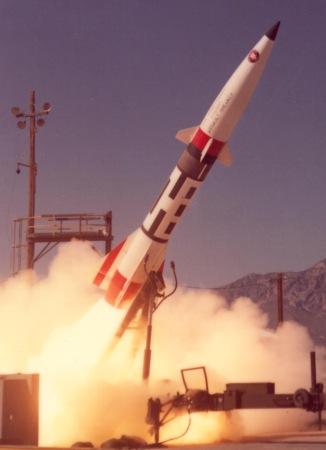Assault Breaker
(Martin Marietta T-16, Vought T-22)
In 1977, DARPA began the Assault Breaker program to develop a system to detect and destroy concentrations of mobile tank forces behind the front line. The studies resulted in the concept of a ground-launched guided missile armed with TGSMs (Terminally Guided Submunitions), which is guided to the target area by an airborne long-range surveillance and control radar.
The airborne radar was developed by the U.S. Air Force under the PAVE MOVER program, and eventually evolved into the E-8 JSTARS (Joint Surveillance and Target Attack Radar System) aircraft. PAVE MOVER could detect and track moving tank columns and guide the Assault Breaker missiles to it via a data link. Two types of guided anti-armour submunitions were developed and tested for use in Assault Breaker, the AVCO "Skeet" (as eventually used in the BLU-108/B Sensor-Fuzed Weapon) and the General Dynamics TGSM (Terminally-Guided Sub-Missile) mini-missile.
 |
| Photo: via Scott Ferrin |
| Assault Breaker (T-16) |
To test the Assault Breaker concept, DARPA awarded contracts to Martin Marietta and Vought to convert existing missiles to Assault Breaker test vehicles. Martin Marietta built the T-16 as a derivative of the MIM-104 Patriot, and Vought derived the T-22 from its MGM-52 Lance ballistic missile. The T-16 modification included the option to air-launch the missile. The designations T-16 and T-22 referred to the diameter of the vehicles in inches. Both vehicles could carry 20 submunitions and had ranges of about 100 km (T-16) and 120 km (T-22), respectively.
 |
| Photo: Lockheed Martin |
| Assault Breaker (T-22) |
In the 1981/82 time frame, a total of 14 Assault Breaker test flights occurred, ten with the T-16 and four with the T-22. These tested target acquisition and tracking by the PAVE MOVER radar, missile guidance (inertial and via data link), dispensing of submunitions, and target engagement by the submunitions. Relatively few tests proceeded without problems, and the system was never tested against fully combat-realistic (i.e. multiple moving) targets. Because of high costs and limited success, the Assault Breaker program was halted in late 1982. Assault Breaker's role of attacking armoured targets behind the lines was eventually incorporated into the U.S. Army's MGM-140 ATACMS (Army Tactical Missile System) missile.
Specifications
The T-16 was derived from the MIM-104 Patriot and the T-22 was derived from the MGM-52 Lance, q.v. for general data. Further information about the exact physical characteristics of the Assault Breaker test vehicles is not available.
Main Sources
[1] R.T. Pretty (ed.): "Jane's Weapon Systems 1982-83", Jane's, 1983
[2] U.S. Congress, Office of Technology Assessment: "New
Technology for NATO: Implementing Follow-On Forces Attack", 1987
[3] Redstone Arsenal Historical Information Website
Back to Directory of U.S. Military Rockets and Missiles, Appendix 4
Last Updated: 15 October 2003